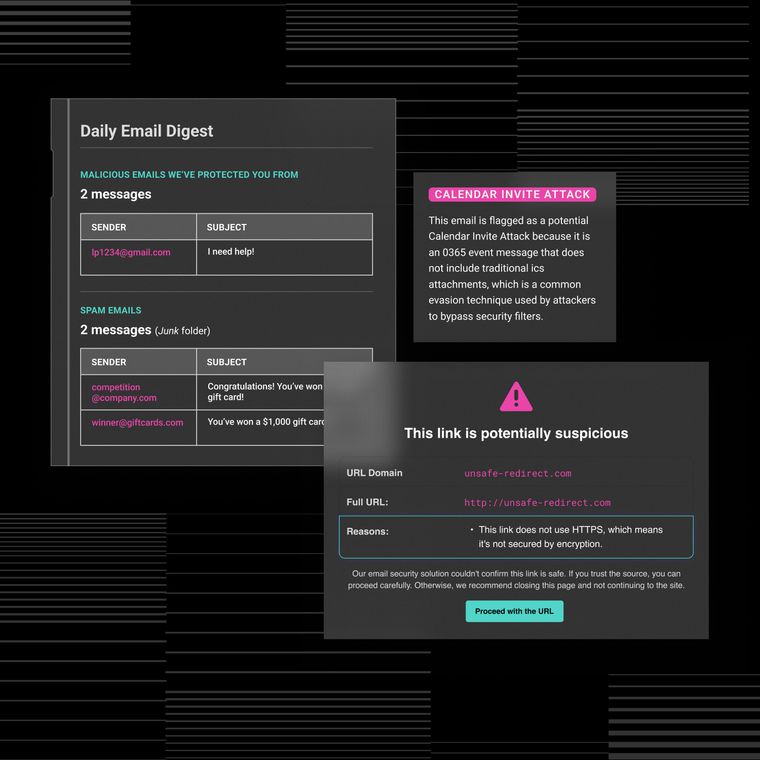5 Critical Insights Driving Transformation in the Banking Sector
Explore five trends shaping email security for technical teams in 2025 and practical steps to help you stay ahead.
August 18, 2025

Ask ten banking executives where cyber risk begins, and most will point to sprawling cloud estates or fragmented payment systems. Ask the security engineers who chase alerts, however, and they will tell you the fight often starts with a single message in an overloaded mailbox. Email remains the bridge between trusted internal users and loosely vetted external contacts, which makes it the natural focus for attackers who prefer low cost and high impact.
Here, we explore five trends shaping email security for technical teams in 2025 and provide practical steps to help you stay ahead.
1. The New Face of BEC Starts Inside Your Supply Chain
Traditional BEC relied on spoofed domains and urgent payment requests. As defences improved, attackers changed tactics. Today, they compromise legitimate supplier accounts, lurk in real conversations, and time fraudulent invoices to match normal billing cycles. Legacy secure email gateways (SEGs), which rely on sender reputation or known-malware signatures, rarely flag a genuine account that suddenly requests a bank detail change.
Action For Practitioners: Deploy behaviour-based analytics that baseline normal replies to patterns, time zones, and payment schedules. A vendor account that changes destination banking information at midnight should raise an immediate interrogation ticket, even when the message comes from an otherwise trusted domain.
2. File-Sharing Phishing Breaks Traditional URL Policies
In the last 18 months, phishing campaigns have pivoted towards cloud collaboration links. Attackers embed a Teams or Google Drive invitation that leads to a fake login page, which collects credentials and session tokens. Users click because they see brands they recognise. Gateways allow the message because the link points to a legitimate cloud platform. Once credentials are stolen, the attacker can run lateral phishing from inside the organisation or launch payroll fraud in human resources portals.
Action For Practitioners: Inspect behaviour around collaboration links, not just the link itself. A new tenant invitation that arrives from an unknown external account, addresses multiple recipients, and appears outside business hours deserves sandbox detonation and user-aware warnings.
3. Tool Sprawl is Now an Attacker’s Advantage
Large banks often run a legacy SEG, an API-based cloud filter, an anti-phishing plugin, and a home-grown header rule set, all before a message even touches the SIEM. Each tool produces its own verdicts, encodings, and false positives. Analysts burn hours correlating alerts to decide whether they describe one threat or three. Meanwhile, genuinely malicious emails age in users’ inboxes. Operational drag is risk.
Action For Practitioners: Start an email signal inventory. List every control that modifies, inspects, or archives an email. Note its data outputs and alert types. Where two controls overlap, pick the one with higher fidelity and retire the rest. A single high-context verdict is worth more than five copies of a low-context alert.
4. SOC Analyst Fatigue Can’t Be Fixed With More Headcount
Banking SOCs face high turnover for a reason. Analysts spend most of the day stitching evidence across tools; they rarely get time for threat hunting. Every alert that lacks context cascades to Tier 2, which creates queues that drive attrition. Talent is expensive and scarce, so success requires better automation, not bigger headcount.
Action For Practitioners: Feed behavioural detections directly into case management with attachments that include raw headers, user risk scores, and vendor risk history. Use automation to merge duplicates, auto-close benign trigger patterns, and pre-populate containment steps. This will allow analysts to focus on novel attacks rather than routine triage.
5. Compliance Deadlines Make Manual Investigation Untenable
Under DORA, banks must notify regulators within 24 hours of a material cyber incident. Some regions are pushing for alerts within four. When the clock starts, exporting logs from five different tools isn’t sustainable. Regulators will not accept “console latency” as an excuse for late notice.
Action For Practitioners: Adopt an email platform that records every decision, verdict, and user action in one audit-ready format. During an incident, the SOC can generate a complete timeline and proof of containment with a single command, meeting legal deadlines without a marathon log hunt.
Connecting the Dots: Why Unified, Behaviour-Based Email Security is the Fastest Win
BEC, phishing, tool sprawl, analyst fatigue, regulatory pressure—these may seem like separate problems, but they all converge in the inbox. Behaviour-driven platforms that use machine learning to profile senders, recipients, and conversation context solve all five simultaneously. They suppress noise, surface real anomalies, and produce rich evidence packs. Most importantly, they do not add yet another console to the stack. They replace legacy layers with a single source of truth.
For practitioners, this shift means fewer tickets, clearer narratives, and incident reports that write themselves. For the organisation, it means lower fraud loss, shorter audits, and a security culture focused on prevention rather than paperwork.
Practitioner Checklist: Your Next 90 Days
Goal | Practical Step |
|---|---|
Cut Duplicate Alerts | Inventory overlapping email controls and retire low-fidelity layers. |
Upgrade Phishing Detection | Enable analytics that score collaboration-link behaviour, not just domain reputation. |
Shrink Investigation Time | Auto-attach context, risk scores, and recommended playbooks to every alert before it reaches Tier 1. |
Prepare for DORA and Similar Mandates | Test incident drills that start with detection and finish with a draft regulator notice in under eight hours. |
Prove Value to Leadership | Track analyst hours returned after consolidation and report them as capacity freed for proactive threat hunting. |
Complexity clouds your signal. Attackers weaponise trust. Regulators count every minute. A unified, behavior-based email platform gives SOC teams fewer tickets, richer evidence, and the speed to meet 24-hour notice rules without overtime.
Ready to take control and start banking on secure email? Schedule a demo today!
Related Posts
Get the Latest Email Security Insights
Subscribe to our newsletter to receive updates on the latest attacks and new trends in the email threat landscape.


